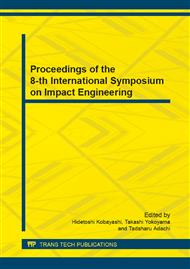[1]
A. Airoldi and B. Cacchione: Modelling of impact forces and pressures in Lagrangian bird strike analysis, Int. J. Impact Engineering, Vol. 32 (2006), p.1651.
DOI: 10.1016/j.ijimpeng.2005.04.011
Google Scholar
[2]
M. Anghileri, LML. Castelleti, F. Invernizzi and M. Mascheroni: A survey of numerical models for hail impact analysis, Int. J. Impact Engineering, Vol. 31 (2005), p.929.
DOI: 10.1016/j.ijimpeng.2004.06.009
Google Scholar
[3]
RAE Mines, S. McKown and RS. Birch: Impact of aircraft rubber tyre fragments on aluminium alloy plates: I-experimental, Int. J. Impact Engineering, Vol. 34 (2007), p.626.
DOI: 10.1016/j.ijimpeng.2006.02.005
Google Scholar
[4]
J. Pernas-Sánchez, D.A. Pedroche, D. Varas, J. López-Puente and R. Zaera: Numerical modeling of ice behavior under high velocity impacts. Int. J. of solids and structures, Vol. 49 (2012), p. (1919).
DOI: 10.1016/j.ijsolstr.2012.03.038
Google Scholar
[5]
D. Varas, J. López-Puente and R. Zaera: Experimental analysis of fluid-filled aluminium tubes subjected to high-velocity impact. Int. J. Impact Engineering, Vol. 36 (2009), p.81.
DOI: 10.1016/j.ijimpeng.2008.04.006
Google Scholar
[6]
D. Varas, R. Zaera and J. López-Puente: Experimental study of CFRP fluid-filled tubes subjected to high-velocity impact. Composite Structures, Vol. 93 (2011), p.2598.
DOI: 10.1016/j.compstruct.2011.04.025
Google Scholar
[7]
Z. Guo, W. Zhang, X. Xiao, G. Wei and P. Reng: An investigation into horizontal water entry behaviors of projectiles with different nose shapes. Int. J. Impact Engineering, Vol. 49 (2012), p.43.
DOI: 10.1016/j.ijimpeng.2012.04.004
Google Scholar
[8]
D. Varas, R. Zaera and J. López-Puente: Numerical modeling of the hydrodynamic ram phenomenon. Int. J. Impact Engineering, Vol. 36 (2009), p.363.
DOI: 10.1016/j.ijimpeng.2008.07.020
Google Scholar
[9]
D. Varas, J. López-Puente and R. Zaera: Numerical analysis of the hydrodynamic ram phenomenon in aircraft fuel tanks. AIAA Journal, Vol. 50 (2012), p.1621.
DOI: 10.2514/1.j051613
Google Scholar
[10]
LS-DYNA Users Manual, Version 971, Livermore Software Technology Corporation, May (2007).
Google Scholar
[11]
G.R. Johnson and W.H. D Cook: A constitutive model and data for metals subjected to large strains, high strain rates, and temperatures. Proceedings of Seventh International Symposium on Ballistics, The Hague, The Netherlands, 1-7 (1983).
Google Scholar


